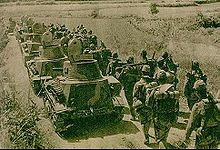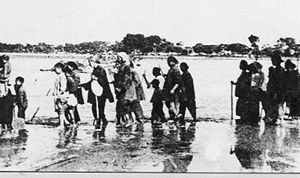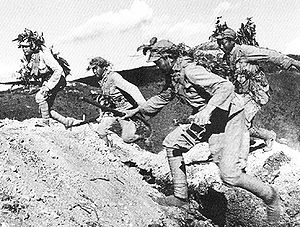History of the PRC – Part Fifteen Posted by sasha on Mar 4, 2011 in Culture
After the Nanjing Massacre, the city of Wuhan became the political, economic, and military center of China. With the fall of Shanghai and Nanjing, this city on the Yangtze River (长江 – Cháng jiāng) was basically the wartime capital of China, and Chinese focused their efforts on defending it. Japanese forces believed that if they could take Wuhan, the Chinese would give up their resistance. The major battle in Wuhan was preceded by a series of air strikes, including one on April 29, 1938 to celebrate the Emperor of Japan’s birthday. As Chinese forces were expecting this attack, they were well prepared, shooting down 21 Japanese planes and losing only 12. While the Japanese were planning on taking down the National Revolutionary Army once and for all, the Chinese were busy as well, amassing one million troops, around 200 planes and 30 naval ships in preparation for the Japanese move on Wuhan.
In another attempt at delaying the Japanese, Chiang Kai-shek decided to open the dikes on the Yellow River near Zhengzhou. The resulting flood, known as the 1938 Yellow River flood (花园口决堤事件 – Huā yuán kǒu jué dī shì jiàn), delayed the Japanese attack on Wuhan. However, it also caused a great deal of damage, as thousands of villages were destroyed and millions of people were made refugees. It is also believed to have caused somewhere between 500,000-900,000 deaths.
Eventually, the Japanese did reach Wuhan, and the next four and a half months featured countless battles. This time is known in China as the defense of Wuhan (武汉保卫战 – Wǔ hàn bǎo wèi zhàn), and it was the longest and and largest battles of the entire war. Taking Wuhan and getting China to surrender wasn’t exactly as easy as Japan had expected, and the Japanese forces were considerably weakened during fighting around Wuhan. In one particular battle, which the Chinese call the Victory of Wanjialing (万家岭大捷 – Wàn jiā lǐng dà jié), four Japanese regiments were completely annihilated by Chinese defenders. Basically, the Chinese strategy at this time can be called “winning by outlasting,” as they prolonged the war and exhausted Japanese military resources while buiilding up their own. However, China’s air force and naval force were essentially wiped out, and the Japanese did end up taking Wuhan. The next few years of the Second Sino-Japanese War were a stalemate, with no major Japanese offensives until 1941. While the KMT and the CCP had been able to work together to fight off the Japanese, their issues with each other would soon prove to be too big to ignore…
http://www.youtube.com/watch?v=7TaQvMk6imM&feature=related
Short video in Chinese about the Battle of Wuhan.

Build vocabulary, practice pronunciation, and more with Transparent Language Online. Available anytime, anywhere, on any device.
About the Author: sasha
Sasha is an English teacher, writer, photographer, and videographer from the great state of Michigan. Upon graduating from Michigan State University, he moved to China and spent 5+ years living, working, studying, and traveling there. He also studied Indonesian Language & Culture in Bali for a year. He and his wife run the travel blog Grateful Gypsies, and they're currently trying the digital nomad lifestyle across Latin America.







Leave a comment: